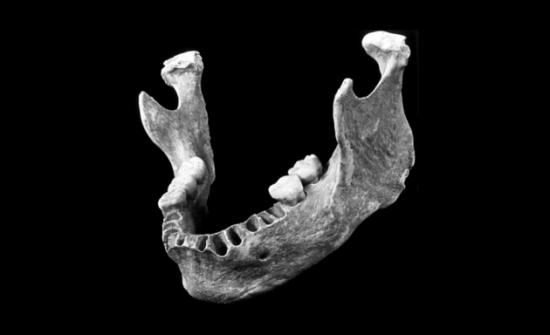Genome of 40,000-year-old jaw from Romania suggests humans interbred with Neanderthals in Europe.
Bob Yirka report
Source - http://phys.org/news/2015-05-analysis-bones-romania-evidence-human.html

This 40,000–year–old human mandible, found in a Romanian cave, has a mix of human and Neanderthal traits; genetic analysis suggests the individual had a close Neanderthal ancestor 4–6 generations back.REF 1 - PNAS
DNA testing of a human mandible fossil found in Romania has revealed a genome with 4.8 to 11.3 percent Neanderthal DNA—its original owner died approximately 40,000 years ago, Palaeogenomicist Qiaomei Fu reported to audience members at a Biology of Genomes meeting in New York last week. She noted also that she and her research team found long Neanderthal sequences. The high percentage suggests, she added, that the human had a Neanderthal in its family tree going back just four to six generations. The finding by the team provides strong evidence that humans and Neanderthals continued breeding in Europe, long after their initial co-mingling in the Middle East (after humans began migrating out of Africa.)
Last year, Fu and her team published a paper describing DNA analysis of a human bone fragment found in an unknown place in Siberia. Dated at 45,000 years old, the team found evidence of Neanderthal DNA, but more importantly, because it was remarkably well preserved, the relic served to strengthen a slower mutation rate than many in the field were embracing. In this new effort, Fu and her team also found that the jawbone (which still had some teeth in it) had visible Neanderthal traits, such as enlarged wisdom teeth. The jawbone was found in a cave accessible only by diving through a watery corridor back in 2002, and has been an object of study ever since. The high percentage of Neanderthal DNA is in sharp contrast to modern out-of-Africa humans, which typically have approximately one to four percent Neanderthal genes.
This latest finding, along with the bone found in Siberia and others in Europe has eroded the belief that human interbreeding with Neanderthals occurred only in the Middle East. It now seems possible that humans and Neanderthals were living in the same geographic areas over the course of five thousand years, which would of course explain why their DNA appears in every person not directly descended from people in Africa, on the planet. What is still a mystery, though, is what happened to the Neanderthal? Why did they disappear even as humans continued on? Eerily, this new evidence suggests that the two were interbreeding very nearly right up to the time when the Neanderthals ceased to exist.
More information: Fu, Q., An early modern human with a recent Neandertal ancestor, talk: meetings.cshl.edu/abstracts/genome2015_absstat.html